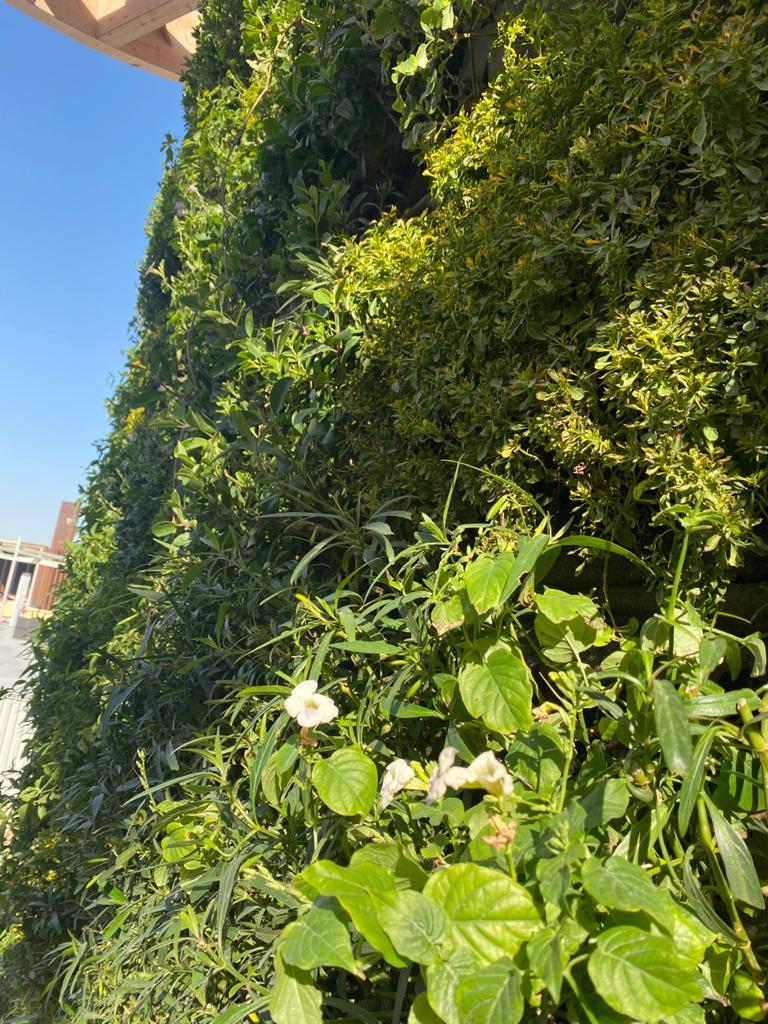
With a total surface of 460 m2 it is by far among the biggest projects in the MEA region.
We are very proud to be a part of the Slovenian pavilion at EXPO 2021 in Dubai, which showcases Slovenia as the green heart of Europe, situated at an important European crossroads combining natural elements: water, forest and wood. It features an eye-catching 6 meters high Urbanscape® Green wall with 45,000 plants. The wall is designed in 11 varieties of locally grown plants in green shades to represent Slovenian forests. The Slovenian Pavilion and its Urbanscape® Green wall is unique for its lush green impact in a desert environment like Dubai, UAE. With a total surface of 460 m2 it is by far among the biggest projects in the MEA region. The Green Wall covers an area of 460 m2, with about 1500 installed green wall panels (30 are custom made) and 45.000 hand-planted local plants selected by the client. The load-bearing structure of green wall panels is represented by more than 1000 meters of various profiles.
A lush green impact in a desert environment like Dubai

The project started in the spring of 2020 and it was definitely specific from several perspectives. It required combining different approaches and a lot of coordination. We had been challenged to find a solution that would represent Slovenia and would at the same time fit in the local environment and climate.
Around the building there was a pool area representing Slovenian lakes as our natural treasure. This meant our solution had to be hydroponic based and not soil based to avoid small soil particles leaching in the pool area which could stain the water.
The installation of the profiles took place in extreme conditions, at extremely high outdoor temperatures. During the installation, the planted plants were already thriving quite nicely which was also noticed by swarms of grasshoppers. Luckily for us, they fed only on one plant species which meant we had to replant “only” a few thousand plants.
The Green Wall covers an area of approximately 500 m2, with about 1,500 installed green wall panels (30 are custom-made) and 45,000 hand-planted local plants selected by the client. The load-bearing structure of the green wall panels is represented by more than 1,000 meters of various profiles. It weights up to 45 kg/m2 when fully saturated with water.
The Urbanscape® Green wall at Expo 2020 is hydroponic based. The growing media used in the green wall is rock mineral, as a light and inert substrate, where nutrient dosing is easier to regulate and the environment is more controlled than in conventional soil substrate mixtures; it is a pH-neutral substrate (7). The rock mineral growing media has an enormous water retention capacity (up to 90% of volume) and is therefore even more suitable for growing plants in arid climate.We are using the most advanced irrigation systems for watering the green walls. The average water consumption on this project will range from less than 2 liters/m2 in winter, and up to 4 liters/m2 in summer (with temperatures exceeding 40°C).
Designer: Urbanscape
Year: 2021
City: Dubai



